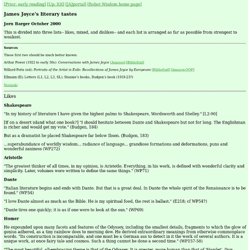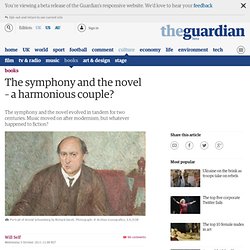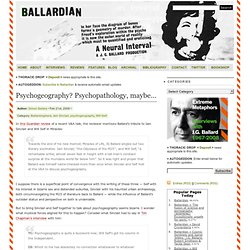

X-POP3-Rcpt: larry@sun. David Foster Wallace - Bookworm on KCRW. Charles Olson. Charles Olson (27 December 1910 – 10 January 1970) was a second generation American modernist poet who was a link between earlier figures such as Ezra Pound and William Carlos Williams and the New American poets, which includes the New York School, the Black Mountain School, the Beat poets, and the San Francisco Renaissance.

Consequently, many postmodern groups, such as the poets of the language school, include Olson as a primary and precedent figure. He described himself not so much as a poet or writer but as "an archeologist of morning. " Life[edit] The Black Veil: Amazon.co.uk: Rick Moody. As did William Styron, Rick Moody has focused his writerly abilities on depression in this volume.

Moody, the middle child, had divorced parents, the divorce event having transpired in 1970 when the family was living in Darien, CT. The home had been quiet. His father's favorite book was MOBY DICK. The Way of All Flesh. In 1998, the Modern Library ranked The Way of All Flesh twelfth on its list of the 100 best English-language novels of the 20th century Main characters[edit] Pontifex family.

First generation "Old" John Pontifex (16 August 1727 – 8 February 1812)Ruth Pontifex (13 October 1727 – 10 January 1811; wife of Old Pontifex; married 1750). Second generation George Pontifex (c.1765–1838; son of Old John and Ruth Pontifex; married c.1797 to unnamed woman who died 1805). Third generation Eliza (1798-18?? Fourth generation. Mating: Amazon.co.uk: Norman Rush. James Joyce's literary tastes. [Prior: early reading] [Up: IQI] [JAJportal] [Robot Wisdom home page] James Joyce's literary tastes Jorn Barger October 2000 This is divided into three lists-- likes, mixed, and dislikes-- and each list is arranged as far as possible from strongest to weakest.

Sources. Donald Barthelme. The symphony and the novel – a harmonious couple? The high arts of literature and music stand in a curious relationship to one another, at once securely comfortable and deeply uneasy – rather like a long-term marriage.

William Blake's picture of God. Go to see the newly acquired etchings by William Blake at Tate Britain, or take a look online.

They display all the unsettling power and apocalypticism we expect from this exceptional, romantic artist. One shows a young man tethered to a globe of blood by his hair. Ragnarök: the doom of the gods. Myth comes from muthos in Greek, something said, as opposed to something done.

We think of myths as stories, although, as Heather O'Donoghue says in her book From Asgard to Valhalla, there are myths that are not essentially narratives at all. Psychogeography? Psychopathology, maybe… In this Guardian review of a recent V&A talk, the reviewer mentions Ballard’s tribute to Iain Sinclair and Will Self in Miracles: Towards the end of his new memoir, Miracles of Life, JG Ballard singles out two literary soulmates: Iain Sinclair, “the Odysseus of the M25″; and Will Self, “a remarkable writer, almost seven feet in height with a tall man’s constant surprise at the mundane world far below him”.

So it was right and proper that Ballard was himself name-checked more than once when Sinclair and Self met at the V&A to discuss psychogeography. Collection of JG Ballard critical articles. The Overloaded Man. So I've been reading these J.G.

Glasshouse (novel) Stross wrote of the book's production: Glasshouse appeared, almost fully formed, in my head between 2:30 p.m. and 3:45 p.m. in the afternoon of March 23, 2003, while I was at the pub nattering with a friend.

I held it off for all of two weeks or so, until April 8th, when the compulsion to start writing became too strong to resist, and the first draft emerged in just three weeks of obsessive 12-hour days. Alice Munro. Alice Ann Munro (/ˈælɨs ˌæn mʌnˈroʊ/, née Laidlaw /ˈleɪdlɔː/; born 10 July 1931) is a Canadian author writing in English. Munro's work has been described as having revolutionized the architecture of short stories, especially in its tendency to move forward and backward in time.[2] Her stories embed more than announce, reveal more than parade.[3] Life and work[edit] Early life[edit] Career[edit] Munro's highly acclaimed first collection of stories, Dance of the Happy Shades (1968), won the Governor General's Award, Canada's highest literary prize.[15] That success was followed by Lives of Girls and Women (1971), a collection of interlinked stories.
Eunoia: Amazon.co.uk: Christian Bok. 1982, Janine. Lost in the Funhouse. Lost in the Funhouse (1968) is a short story collection by American author John Barth. The postmodern stories are extremely self-conscious and self-reflexive and are considered to exemplify metafiction. Though Barth's reputation rests mainly on his long novels, the stories "Night-Sea Journey", "Lost in the Funhouse", "Title" and "Life-Story" from Lost in the Funhouse are widely anthologized.